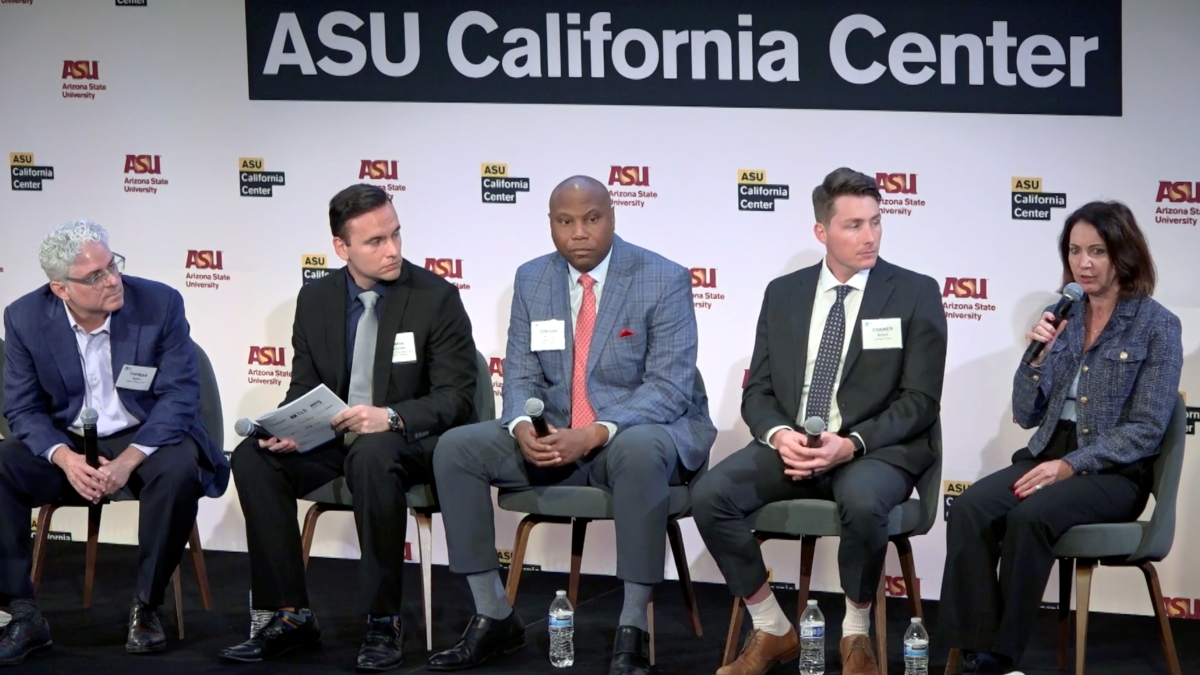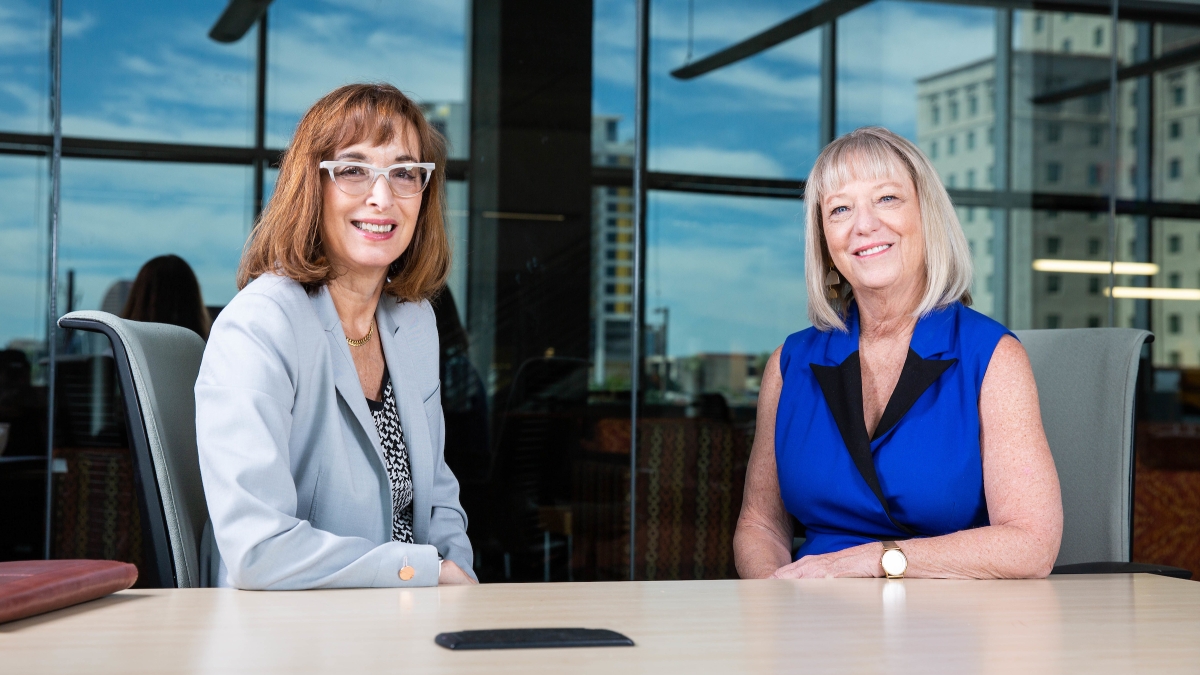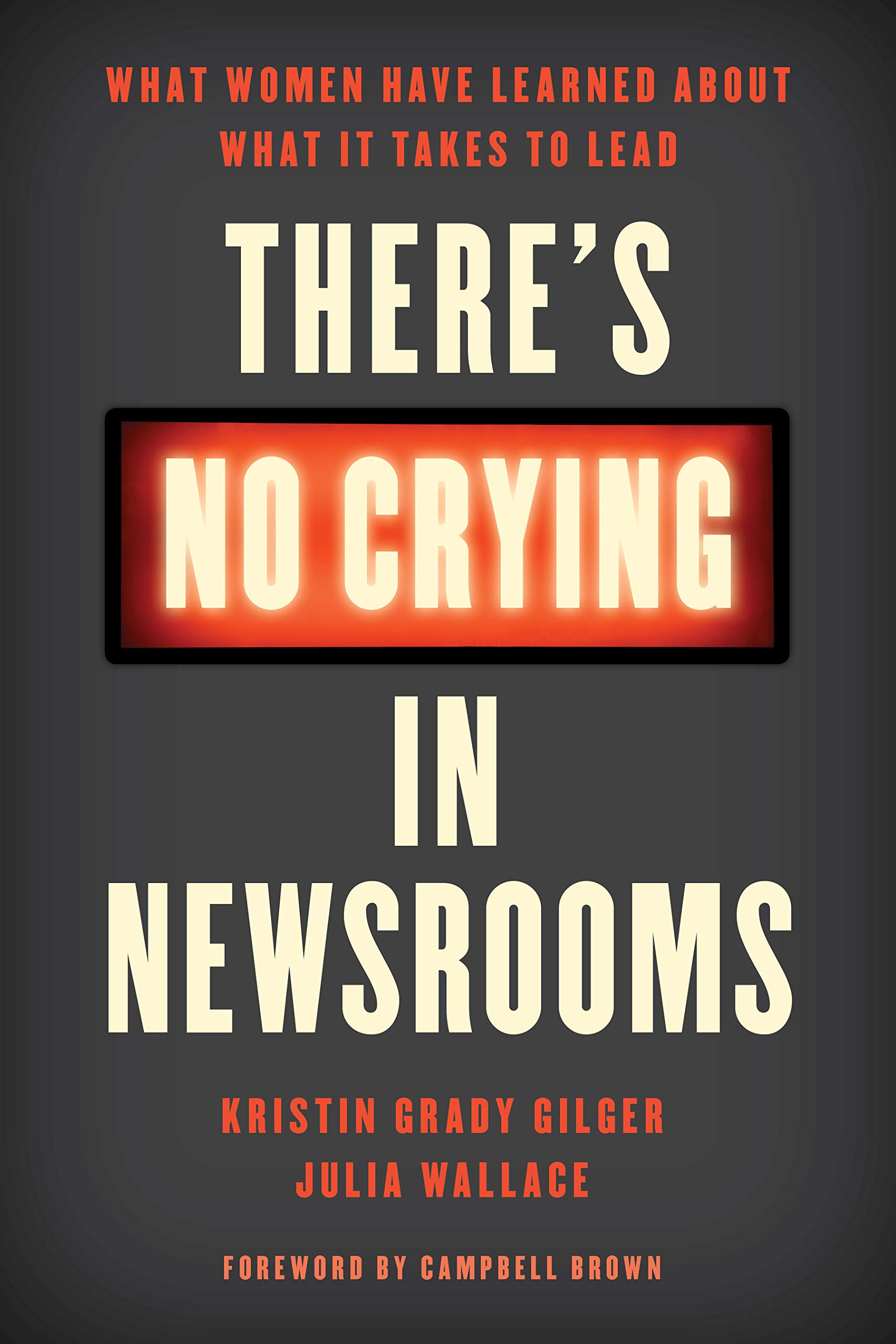Finding a leadership style that works. Navigating workplace culture. Balancing work and family. Dealing with sexual harassment.
These are just some of the challenges women face in the workplace, but especially so in the rambunctious world of media, in which personalities are large, the stakes are high and mistakes are all too visible.
“There’s No Crying in Newsrooms: What Women Have Learned About What It Takes to Lead” (Rowman & Littlefield Publishers, 2019), by Arizona State University professors Kristin Grady Gilger and Julia Wallace, tells the stories of remarkable women who have broken through barrier after barrier at media organizations around the country since the 1970s — and describes the challenges women still face as they navigate their way to the top.
According to the book’s authors, many of these pioneers “started out as editorial assistants, fact checkers and news secretaries and ended up running multimillion-dollar news operations that determine a large part of what Americans read, view and think about the world. These women, who were calling in news stories while in labor and parking babies under their desks, never imagined that 40 years later, young women entering the news business would face many of the same battles they did — only with far less willingness to put up and shut up.”
ASU Now spoke to Gilger, senior associate dean and Reynolds Professor in Business Journalism at the Walter Cronkite School of Journalism and Mass Communication and Julia Wallace, formerly a top media executive and high-ranking editor at four major newspapers and now the Frank Russell Chair at the Cronkite School, about the findings in their 216-page book.
Question: The book’s title is intriguing. What does it mean to you?
Julia Wallace: Thanks. We really struggled over the title. People ask, “What was the hardest part about writing a book?” In some ways, it was the title! We went through so many bad ones. Some were boring. Some were inaccurate. Some were … well, inappropriate. We asked friends. We made lists. Nothing was working.
Kristin Gilger: We were in crunch time. Then one afternoon, my daughter and I were getting our hair cut, and we spent the entire time running book title ideas past our hairdresser. As we were driving home, it hit me. “A League of Their Own” has always been one of my favorite movies, and there’s this iconic scene in which Tom Hanks, who plays the coach of an all-female baseball team during World War II, confronts one of his players who is crying on the field. His response is to yell at her, “There’s no crying in baseball!” I love that scene. And I’ve told way too many women, “There’s no crying in newsrooms.” Newsrooms have always been tough, male-dominated places where you can kick a trash can, but you better not show any sign of weakness. I’m not endorsing that, and I actually think it’s changing, but the title gets across the point that the women who have risen to the top of news organizations have not had an easy time of it.
Q: Now that you’ve hooked me, can you give me an anecdote when you were actually driven to tears in the newsroom or an incident that pushed you to the edge?
JW: One moment is seared into my brain. My boss called me into her glass office and told me that I was being transferred from a job I loved to one I was convinced I would hate. I cried, not just a little, but loud enough that people in the newsroom starting peering through the glass at me. When I left, everyone just pretended not to see me at all. Eventually, I came to terms with the job change, and years later, I realized it was a wake-up call that was critical to my success. But at the time I was humiliated, and I told myself I would never cry publicly again, and, for the most part, I’ve stuck to that.
Q: Was it difficult to co-author a book? There are so many horror stories of authors working together.
KG: I had thought about writing a book about women leaders in news for a long time, but there was no way I could tackle a project of that size by myself — not while working my day job! Our dean, Christopher Callahan, suggested I enlist Julia, and it was a perfect fit. We had worked together twice before — at the Salem Statesman-Journal in Oregon and at The Arizona Republic here in Phoenix. We had pretty heavily female leadership teams at both papers. I remember one time in Oregon, Julia decided we should embrace it, declaring we would observe “Barbie Day” in the newsroom. We all dressed up like Barbies — tied to events in the news. The city editor dressed up like prison Barbie and set up a ring of barbed wire around her desk.
Joking aside, we valued the opportunity to create a different kind of newsroom culture, one that we tried to make inclusive and welcoming for working parents. (We both brought our kids to work multiple times.) For the book, I spent several days with the two women who co-edited Mother Jones magazine for a number of years. When they proposed the idea, almost no one thought two women would succeed sharing a position, but they ended up proving the skeptics wrong. I think Julia and I did that, too. We brought different skills to the job, and we have great respect for each other. We literally did not have one fight!
Q: What was your motivation for writing this book, and how long did it take?
KG: I had been thinking about this topic for years. I knew a lot of women who rose into management positions at news organizations around the same time I did, and no one had really captured their stories. Also, when I listened to what my daughters and our students were telling me about their experiences, I was struck by how many of them still face the same kind of challenges that we did. I wanted to write a book that describes an important piece of journalism history, with stories of women like Jill Abramson of The New York Times and Christiane Amanpour of CNN. But I also wanted to offer some lessons from one generation to the next.
JW: After I was hired to join the faculty at ASU (before I even arrived), Kristin told me about her idea and asked if I wanted to write this book with her. I said, “Yes,” immediately. Kristin and I had worked together 20 years ago, and I knew we’d be a great writing team. Also, I loved the topic and thought it was a story that needed to be told. As I began teaching, I understood even more the need to tell these stories and pay it forward to the next generation. It took us about two years to complete the book, but most of the work done during six months of no weekends, no vacations and very little sleeping.
Q: I initially thought this would be a memoir about your collective experiences, but you interviewed almost 100 female journalists for the book. What did they end up telling you that you didn’t know, and how valuable were their contributions?
JW: I learned a lot about the women who went before us. I walked into newsrooms just as they were beginning to change. I arrived in my first newsroom in the summer of 1975 when women were allowed to wear pants to work for the first time. I was actually the first woman to smoke in that newsroom because the publisher believed it was “unladylike” for women to smoke. Back then, I didn’t understand that I wouldn’t have been sitting in that newsroom if it weren’t for the brave women before me who have filed lawsuits and challenged the status quo. I didn’t understand that even though I faced challenges, they were nothing compared to people like Aggie Underwood, one of the first women city editors in the U.S. She kept a baseball bat on her desk and a gun loaded with blanks in her drawer just so the men would take her seriously.
KG: For me, the really eye-opening part was interviewing young women for our chapter on the next generation of women journalists. We, meaning women of my generation, spent too many years going along, assuming that if we just did the work — better than anyone else — we would be rewarded, get to the top and then make the changes that we thought were needed. Young women today — and we see this with the #MeToo movement — just aren’t as willing to put up and shut up as we were. They are changing all sorts of rules, and that’s a great advance. One example: Melissa Bell, the publisher of Vox Media, talks about how she has become much more comfortable crying in the newsroom and it hasn’t hurt her credibility at all. It’s encouraging to see these women changing workplace cultures, although I still don’t advise my students to cry in the newsroom!
Q: What’s intriguing is that journalists in the 1960s advocated for civil rights in their coverage and op-eds, and only a few years later, those same journalists were slow to warm to women in newsrooms. Why do you think that is?
JW: When the Civil Rights Act of 1964 passed, I don’t think anyone understood the impact it would have on women in the workplace. It was intended to correct horrific job discrimination based on race. At the last minute, the words "sex" (note: not gender) was added to the language. It’s a bit of a shock to see the news photos of President Lyndon Johnson signing the bill — surrounded by men. Only a handful of photos, shot with a wide lens, show any women at all, and they’re in the very back of the room.
KG: That’s a really good question, but if you think about it, the same thing happened with the right to vote. Women came last. It took a series of lawsuits by women at places like The New York Times and Newsweek to force changes in pay, access and jobs. Women at Newsweek, for example, weren’t considered reporter material; they were assigned to male reporters as assistants and fact-checkers. We came across a transcript of a 1973 meeting of the American Society of Newspaper Editors that perfectly illustrates what it was like at the time. The theme of the conference was “Problems in Journalism,” and an entire morning was devoted to the particular problem of women in newsrooms. The women spoke first and in a fury about being thrown out, felt up, passed over, ignored and humiliated, and they illustrated their points with a skit that was alternately hilarious and devastating. In one exchange, a male city editor tells a woman she isn’t management material because she has periods. The woman, referred to as a “newshen” in the script, replies: “Yes, Nick, yes. Women have periods. They have commas; they have semicolons; some of them even have complete sentences.”
Q: How did this start to change over time, and what was pushing this change?
KG: It changed because the world changed. Laws were passed outlawing discrimination, and media companies were losing lawsuits, which meant they were paying out real money. For the most part, companies changed because they were forced to. However, they discovered something interesting along the way. Women became some of their top performers. The Associated Press, which fought a sex discrimination suit for years before settling, now has a woman in the top editor job. Once women forced open the doors, they were able to show what they could do.
JW: There have been visionary male leaders who really pushed for change. In the book, we tell the story of Al Neuharth, who, as CEO of Gannett, one of the nation’s largest media companies, pushed and pulled women and people of color into leadership roles. Back in 1969, before any of the lawsuits, Neuharth spoke to a group of women who were editing the women’s sections of newspapers. He challenged them, saying, “Why don’t more of you prepare yourselves for, and set your sights on, such positions as publisher, editor … or any of the top communications jobs on which the ‘For Men Only’ sign should come down?” His company went on to build one of the best diversity records in the business. In one case, Gannett plucked a woman out of a teaching job to make her a publisher. In another, the company took a woman who had been languishing at The Washington Post and put her on a track to become the top editor of one of the more storied newspapers in the South.
Q: Your chapter on sexual harassment in the workplace made me cringe, and certainly takes on new meaning in the #MeToo era. Why was it important for you to include this in the book?
JW: We actually began this book before the #MeToo movement began, but even if it had never happened, we had to talk about the reality of what happens to women in newsrooms and workplaces of all kinds. Virtually every woman we interviewed had a story about sexual harassment. The chapter we devote to this topic tells the story of Mi-Ai Parrish, the Sue Clark-Johnson Professor in Media Innovation at the Cronkite School. For years, she said, she shrugged or laughed off sexualized comments … until she decided enough was enough. While publisher of The Arizona Republic, she decided to go public with a powerful column about then-Arizona legislator Don Shooter, who had made an extremely inappropriate comment to her. That column helped galvanize legislators, who eventually voted to expel Shooter.
KG: While reporting this, we were struck by how differently women have handled harassment. Kate O’Brian, who went on to become a top leader at ABC News, recalled an incident during her first job at ABC when she was just in her 20s. One day, she was in the control room — a small, dark, crowded space — when she felt a hand cradling her behind. At first she was so shocked she didn’t know what to do, but then she decided to go for it. She said, loudly enough for everyone to hear, "Take your hand off my a--!" The control room went silent, which doesn’t happen very often, and, very slowly, the hand backed away. She said no one ever tried that with her again. Nina Totenberg, the legendary reporter for NPR, took a subtler approach. She told us about a White House dinner at which former President Bill Clinton was seated on one side of her and a high-ranking public official on the other. “This public official puts his hand on my leg, and I’m thinking, ‘You can’t make a scene at the White House,’” she said. “What was I going to do? So I held his hand for the whole dinner. I ate with one hand. My theory was the hand couldn’t move if I held it.” And we heard lots of versions in the middle. It was a struggle for women then, and too often it’s still a struggle.
Q: Your book brings up the fact that once women did move up the ladder, they faced new challenges. What were some of those challenges?
KG: Where to begin? Our first chapter is devoted to the question of leadership styles — and how women struggle to find a style that is neither too wimpy nor too bitchy. As one of the women we interviewed put it, women have two choices: They can be either the willful and formidable Scarlett O’Hara or the dutiful and saccharine Melanie Wilkes of “Gone with the Wind” fame. Christiane Amanpour gets really impatient when you ask her about this. She told us it’s about time women stop apologizing for their Scarlett-like tendencies. “Look, I think that women have been playing nice for an awfully long time, playing the game, climbing the ladder, being patient, accepting the tidbits and morsels that are handed out,” she said. “I think that we have to start kicking the door down.”
JW: I was struck by how many women struggled to balance work and family. This is hard for women in any job, but the competitive, 24-hour-a-day nature of journalism makes it an especially challenging profession for women. And when something really big happens — a flood, a hurricane, a mass shooting, a Super Bowl, an election— there usually is only one choice. Jan Leach remembers being in the newsroom of the Akron Beacon-Journal, where she was editor, for four days straight after the Sept. 11, 2001, terrorist attacks. When the news broke that Tuesday morning, her husband called and asked, “Where are the kids?” “I don’t know,” she snapped. “I’m busy.” We devote a chapter in the book to this issue of balance, and we try to offer a hopeful message. Some women, like Sandy Mims Rowe, who was one of the top newspaper editors in the country, have managed to do it all — but they’ll be the first to say they had a lot of help. Support systems are simply crucial.
Q: Given the strides that women have made in newsrooms, sadly you state that the numbers for women in the profession are dwindling, especially in leadership roles. Why is it moving backward in your opinion?
JW: The economic downturn really slowed diversity efforts. Editors and publishers became more focused on saving their newsrooms. What they missed, though, is that diversity — all forms of diversity — is necessary if journalism is to be saved. Unless we represent the communities that we cover and are connected to them in meaningful ways, we really are doomed.
Top photo: Julia Wallace, left, and Kristin Gilger pose for a portrait on the second floor reading room of the Walter Cronkite School of Journalism and Mass Communication on June 26. The two authors recently penned a book: "There’s No Crying in Newsrooms: What Women Have Learned about What It Takes to Lead" which tells the stories of women who broke through barriers at media organizations around the United States. Photo by Deanna Dent/ASU Now
More Law, journalism and politics

TechTainment conference explores the crossroads of law, technology, entertainment
What protections do writers, actors, producers and others have from AI? Will changing laws around name, image and likeness (NIL) eliminate less lucrative college sports?And what does the No…

How to watch an election
Every election night, adrenaline pumps through newsrooms across the country as journalists take the pulse of democracy. We gathered three veteran reporters — each of them faculty at the Walter…
Law experts, students gather to celebrate ASU Indian Legal Program
Although she's achieved much in Washington, D.C., Mikaela Bledsoe Downes’ education is bringing her closer to her intended destination — returning home to the Winnebago tribe in Nebraska with her…

